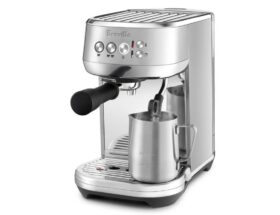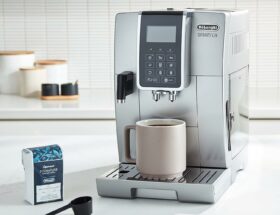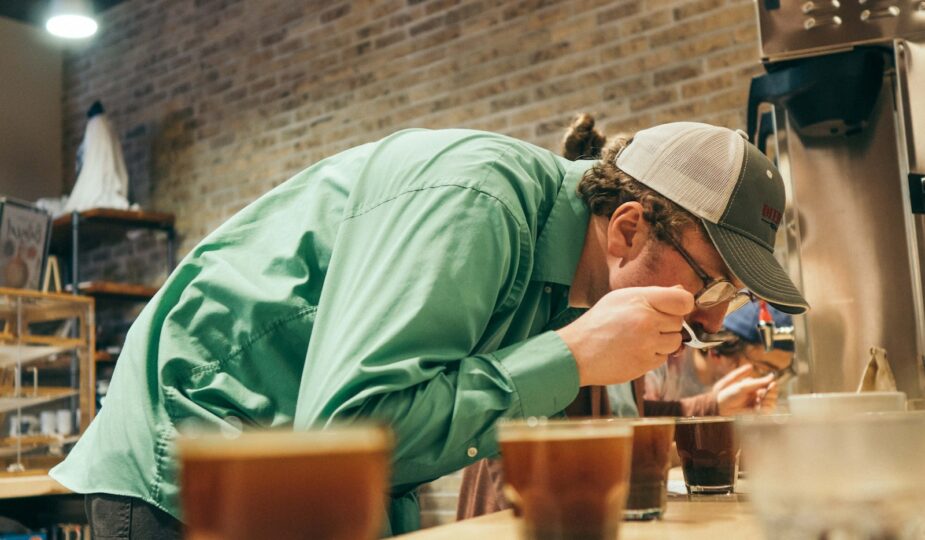
The Art of Coffee Cupping: A Comprehensive Guide
Coffee cupping, often referred to as the “tasting of coffee,” is a fascinating and essential practice in the world of specialty coffee. It’s not just a method for assessing the quality of coffee beans but also a way to unlock the hidden flavors and aromas that make each coffee unique. In this comprehensive guide, we’ll take you through the entire coffee cupping process, from understanding its purpose to perfecting your technique.
Table of Contents
- Introduction to Coffee Cupping
- The Role of Cupping in the Coffee Industry
- Getting Started with Coffee Cupping
- Unlocking Coffee Cupping Flavors
- How to Improve Your Coffee Cupping Skills
- 1. Practice Regularly
- 2. Join Cupping Groups
- 3. Focus on Calibration
- 4. Expand Your Vocabulary
- 5. Sensory Memory Exercises
- 6. Experiment with Brewing Variables
- 7. Mentorship and Feedback
- 8. Attend Coffee Cupping Workshops and Courses
- 9. Use the SCA Flavor Wheel
- 10. Stay Updated
- 11. Embrace Feedback
- 12. Travel and Explore Coffee Origins
- Practical Tips for Novice Cuppers
- Conclusion
- Additional Resources
- Author Bio
Introduction to Coffee Cupping
Why Cupping Matters
Coffee cupping is the industry standard for evaluating coffee quality. It provides an objective way to assess various aspects of coffee, such as flavor, aroma, acidity, body, and balance. Whether you’re a coffee professional, a barista, or a dedicated coffee enthusiast, learning how to cup coffee can deepen your appreciation and understanding of this beloved beverage.
The Role of Cupping in the Coffee Industry
Evaluating Coffee Quality
One of the primary purposes of coffee cupping is to evaluate the overall quality of coffee beans. Professionals use a standardized scoring system to rate coffee on a scale, helping them identify the best beans for various purposes, such as single-origin offerings or blends.
Flavor Exploration
Coffee cupping is a journey into the world of flavors and aromas. By systematically assessing coffee samples, cuppers can detect and describe specific flavor notes, such as fruity, floral, nutty, or spicy. This skill is invaluable for those seeking to appreciate coffee on a deeper level.
Quality Control
Roasters and producers use cupping as a quality control measure. It helps them detect any defects or inconsistencies in coffee batches, ensuring that only the finest beans make it to the consumer’s cup.
Getting Started with Coffee Cupping
Gathering Your Equipment
Before diving into your first cupping session, ensure you have the right tools:
- Scale: For precise measurements.
- Grinder: To grind coffee uniformly.
- Water: Clean and preferably filtered.
- Kettles: For heating water.
- Cups or Bowls: Standardized and uniform.
- Spoons: Cupping spoons are designed for the task.
- Timer: To monitor steeping times.
- Towels: For wiping spoons and cleaning.
- Pens/Pencils: For recording observations.
- Cupping Forms: Standardized evaluation sheets.
- Spittoons: For spitting out samples.
- Consistency in equipment is crucial to ensure consistent results.
Understanding the Evaluation Form
Most cupping sessions use the Specialty Coffee Association (SCA) cupping form, which standardizes the evaluation process. Familiarize yourself with this form, as it guides you in scoring coffee based on attributes like aroma, flavor, aftertaste, acidity, body, and balance.
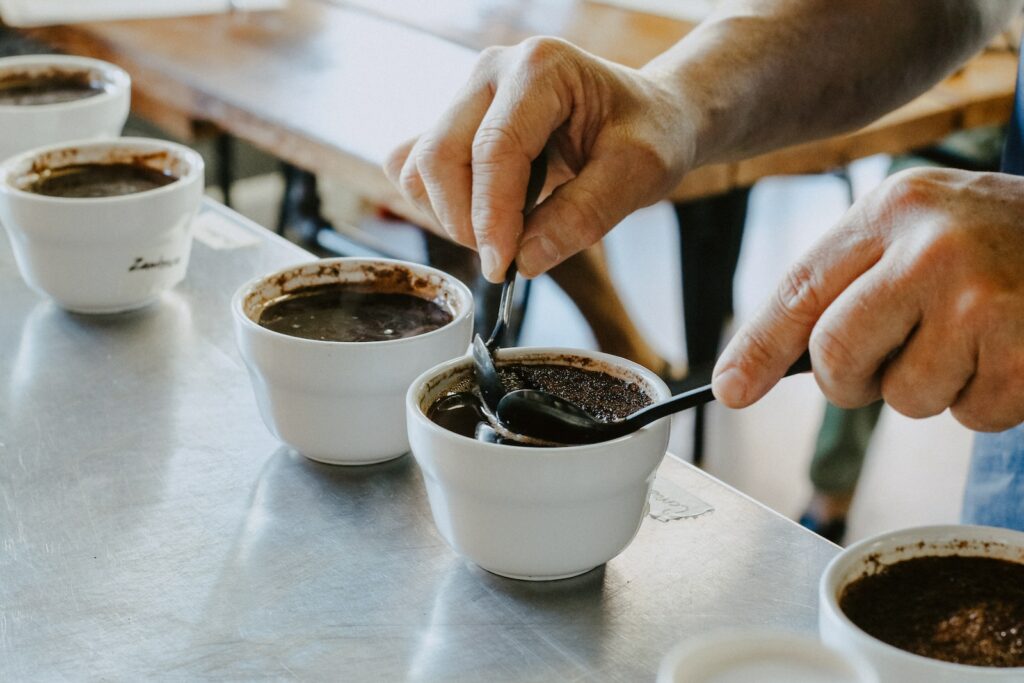
Preparing Your Samples
Proper sample preparation is vital:
- Purge the grinder to eliminate old coffee residues.
- Grind each coffee sample individually to maintain uniformity.
- Ensure consistency in factors like grind size, water temperature, and coffee-to-water ratio.
Sampling the Coffee
The cupping process involves several key steps:
- Smell the dry grounds to identify initial aromas.
- Add hot water to the coffee grounds and let them steep.
- Break the crust that forms on the surface to release intense aromas.
- Taste the coffee using a cupping spoon.
- Rinse your spoon before and after each sample to avoid contamination.
How to Avoid Common Errors
To ensure an accurate and unbiased cupping experience, avoid these common errors:
- Influencing Others: Refrain from discussing your observations with others during the cupping session to prevent influencing their evaluations.
- Excessive Caffeine Intake: Spitting out samples helps prevent caffeine overload and palate fatigue.
- Consistency: Maintain a consistent approach to cupping to ensure reliable results.
Unlocking Coffee Cupping Flavors
The Magic of Coffee Cupping
Coffee cupping allows you to explore a wide range of flavors, from the bright acidity of Ethiopian Yirgacheffe to the deep chocolate notes of a Brazilian coffee. The longer steeping times during cupping reveal subtle nuances that may go unnoticed in other brewing methods.
Identifying Flavor Notes
As you progress in your coffee cupping journey, you’ll develop the ability to detect and describe specific flavor notes. These can range from fruity and floral to spicy and earthy, depending on the coffee’s origin and roast profile.
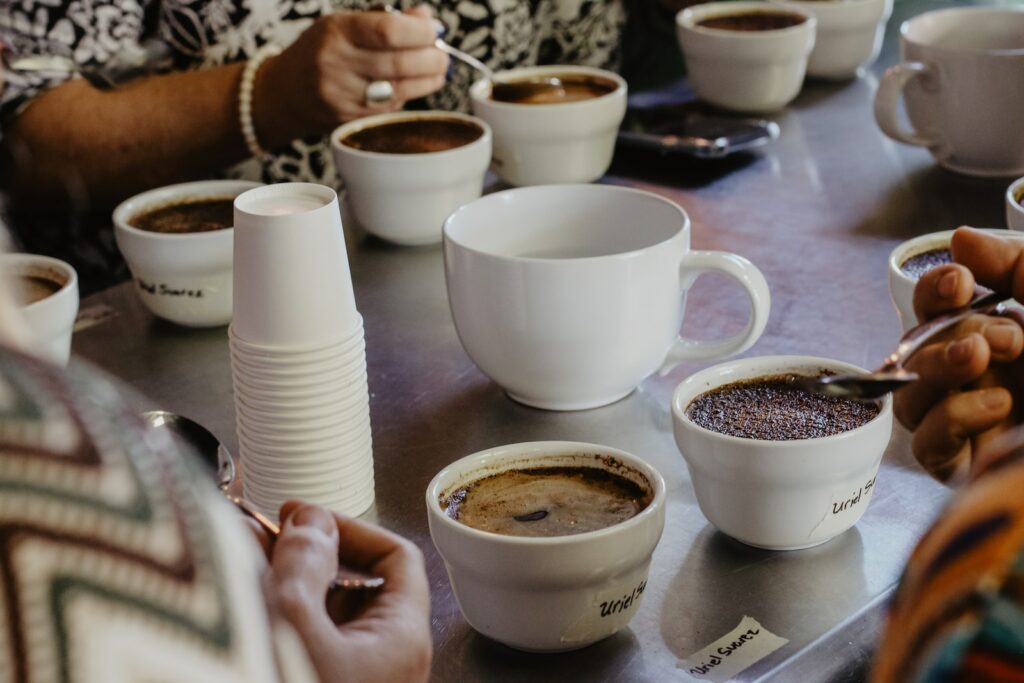
How to Improve Your Coffee Cupping Skills
Becoming a proficient coffee cupper is a continuous journey that involves honing your sensory perception and expanding your knowledge of coffee. Here are some strategies to help you enhance your coffee cupping skills:
1. Practice Regularly
As with any skill, practice is paramount to improvement. The more you engage in cupping sessions, the more refined your palate becomes. Aim to schedule regular cupping sessions, whether alone or with friends, to keep your senses sharp and your taste memory active.
2. Join Cupping Groups
Participating in cupping groups or coffee tasting events in your community or online can provide valuable learning opportunities. Experienced cuppers often lead these sessions, guiding participants through the process and sharing insights. Joining such groups allows you to explore a wide range of coffees and receive feedback from others.
3. Focus on Calibration
Calibration involves aligning your sensory perceptions with those of experienced cuppers. This process helps ensure that you’re consistently evaluating coffee in the same way as others. Consider participating in calibration exercises with a mentor or a group of cuppers. This practice can help you standardize your scoring and descriptions.
4. Expand Your Vocabulary
Developing a rich vocabulary for describing coffee flavors and aromas is crucial. To do this, expose yourself to a variety of sensory experiences beyond coffee. Taste different fruits, spices, herbs, and chocolates, and take note of their distinct characteristics. Over time, you’ll be able to draw parallels between these flavors and the coffee you’re cupping.
5. Sensory Memory Exercises
Strengthen your sensory memory by engaging in exercises that challenge your ability to recall specific aromas and flavors. Blindfolded smell tests, where you identify various scents, or blind taste tests with different foods can help sharpen your sensory skills. These exercises develop your ability to pinpoint subtle notes in coffee.
6. Experiment with Brewing Variables
To deepen your understanding of coffee, experiment with different brewing variables outside of traditional cupping. Try brewing the same coffee using various methods like pour-over, French press, or espresso. This hands-on exploration can help you connect the dots between cupping scores and the flavors produced in a real-world brew.
7. Mentorship and Feedback
Seek mentorship from experienced cuppers or professionals in the coffee industry. A mentor can provide personalized guidance, share their knowledge, and offer constructive feedback on your cupping technique. Don’t hesitate to ask questions and request evaluations of your cupping notes.
8. Attend Coffee Cupping Workshops and Courses
Consider enrolling in coffee-related workshops or courses, especially those focused on sensory analysis and cupping. Many specialty coffee associations offer educational programs that cover various aspects of coffee tasting. These courses provide structured learning and access to industry-standard cupping practices.
9. Use the SCA Flavor Wheel
The Specialty Coffee Association (SCA) Flavor Wheel is a valuable tool for describing coffee flavors. Familiarize yourself with this wheel, which categorizes coffee flavors into broader and more specific descriptors. When cupping, reference the wheel to help articulate the nuanced notes you encounter.
10. Stay Updated
The coffee industry is dynamic, with new origins, varieties, and processing methods constantly emerging. Stay updated with the latest trends and developments in the coffee world. Reading industry publications, following coffee blogs, and attending coffee expos can help you stay informed and inspired.
11. Embrace Feedback
Don’t shy away from constructive criticism. Share your cupping notes with peers and mentors, and welcome their feedback. Recognize that feedback is a valuable tool for growth, helping you refine your skills and expand your knowledge.
12. Travel and Explore Coffee Origins
If possible, embark on coffee origin trips to witness coffee production firsthand. Visiting coffee farms and processing facilities offers a deeper appreciation for the entire coffee supply chain. Understanding how factors like terroir and processing methods influence flavor can elevate your cupping expertise.
In conclusion, the path to becoming a skilled coffee cupper involves dedication, curiosity, and a commitment to continuous learning. By practicing regularly, seeking guidance, and expanding your sensory experiences, you’ll not only improve your coffee cupping skills but also gain a profound appreciation for the intricate world of coffee flavors. Enjoy your journey of exploration and discovery in the realm of coffee!
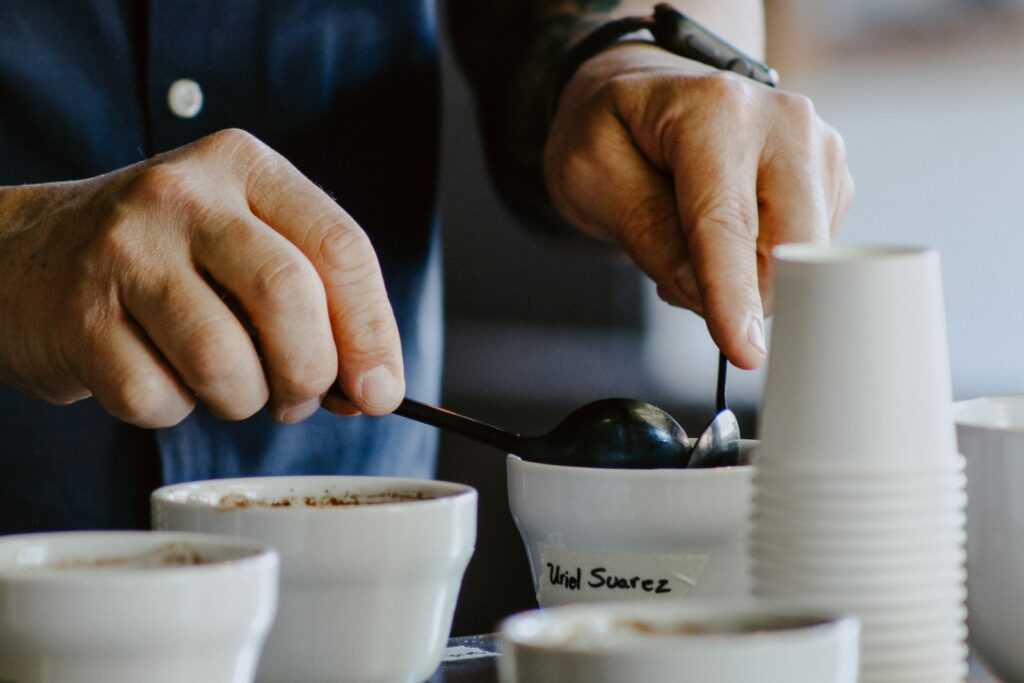
Practical Tips for Novice Cuppers
If you’re new to coffee cupping, it’s essential to approach it with an open mind and a willingness to learn. Here are some practical tips to help you make the most of your cupping sessions:
1. Start with a Variety of Coffees
As a novice cupper, your goal should be to expand your palate and develop a broad understanding of coffee flavors. Begin by sourcing a diverse selection of coffee beans from different regions, such as Ethiopia, Colombia, Kenya, and Brazil. Each origin offers unique flavor profiles that will challenge and educate your taste buds.
2. Keep a Cupping Journal
Maintaining a cupping journal is an invaluable practice. Create a dedicated notebook where you record your observations for each cupping session. Note the coffee’s origin, roast level, and any specific details about the beans. Document your sensory experiences, including aroma, flavor notes, acidity, body, and aftertaste. Over time, this journal will become a valuable reference that helps you track your progress and preferences.
3. Don’t Rush the Process
Coffee cupping is not a race. Take your time to savor each cup. Begin by inhaling the dry coffee grounds’ aroma, noting the initial scents that greet your nose. Then, during the steeping phase, allow the coffee to bloom and release its full range of aromas. When you break the crust and start tasting, take small, deliberate sips to fully appreciate the flavors. Avoid rushing through the samples; it’s about quality, not quantity.
4. Experiment with Variables
While consistency is crucial in coffee cupping, it’s also a valuable learning experience to experiment with different variables. For instance, you can vary the water temperature, steeping time, or grind size slightly to see how these factors influence the flavor profile of the coffee. This experimentation will deepen your understanding of how each element affects the final cup.
5. Seek Feedback and Discussion
Engage in discussions with fellow cuppers. Share your observations and listen to theirs. Discussing the coffee’s flavors and characteristics with others can broaden your perspective and help you identify subtleties you might have missed. Don’t hesitate to ask questions or seek feedback; the coffee community is often eager to help newcomers.
6. Join Cupping Sessions
If possible, attend organized cupping sessions hosted by coffee professionals or local coffee communities. These gatherings provide an excellent opportunity to learn from experienced cuppers, explore a wider range of coffees, and gain exposure to different cupping protocols. Plus, they offer a chance to connect with fellow coffee enthusiasts.
7. Embrace the Learning Curve
Remember that coffee cupping is a skill that takes time to develop. You may encounter challenges along the way, such as struggling to identify specific flavor notes or inconsistencies in your scoring. Embrace these moments as opportunities for growth. With persistence and practice, your palate will become more refined, and you’ll gain confidence in your ability to assess coffee.
8. Sample Food with Similar Notes
To refine your flavor recognition skills, try tasting food or beverages that contain flavor notes commonly found in coffee. For example, sample different chocolates with varying cacao percentages to familiarize yourself with chocolatey notes. Explore fruits, nuts, and spices to connect them with the corresponding coffee descriptors. This cross-training can enhance your ability to pinpoint and articulate flavors in coffee.
9. Stay Curious
The world of coffee is vast and endlessly fascinating. Stay curious and open to new experiences. Continuously seek out opportunities to explore different coffee origins, processing methods, and roast profiles. Attend coffee-related events, read coffee literature, and engage with the coffee community online to stay inspired and informed.
In conclusion, coffee cupping is a journey of discovery and refinement. By following these practical tips and embracing the learning process, you’ll not only enhance your coffee cupping skills but also deepen your appreciation for the diverse and complex world of coffee flavors. Happy cupping!
Conclusion
Coffee cupping is a rewarding and enlightening experience that allows you to connect with the world of coffee on a deeper level. Whether you’re pursuing a career in the coffee industry or simply seeking to enhance your coffee appreciation, mastering the art of coffee cupping is a valuable endeavor. So, gather your tools, invite friends or colleagues, and embark on a journey of flavor discovery through the world of coffee cupping.
Additional Resources
For more in-depth information on coffee cupping and palate development, consider exploring these valuable resources:
Author Bio
About the author: Mike is a dedicated coffee enthusiast with 5 years of experience in the coffee industry. He is passionate about sharing their knowledge and love for coffee with readers worldwide.


